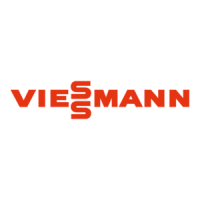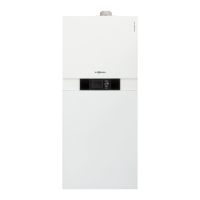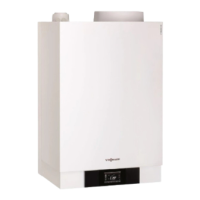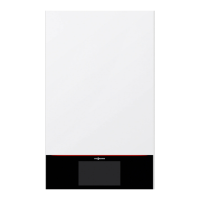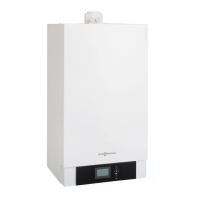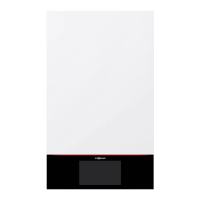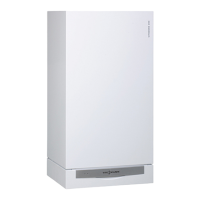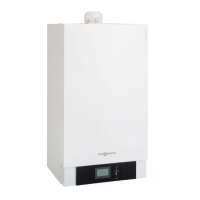What causes fault code C3 on a Viessmann Vitodens 222-F?
- TtheresahallAug 30, 2025
If your Viessmann Boiler displays fault code C3, it indicates an Extension AM1 communication error. Check electrical connections.











What causes fault code C3 on a Viessmann Vitodens 222-F?
If your Viessmann Boiler displays fault code C3, it indicates an Extension AM1 communication error. Check electrical connections.
What to do if Viessmann Boiler displays fault code A9?
If your Viessmann Boiler displays fault code A9, it indicates that the internal circulation pump is blocked. You should check the circulation pump.
What does error code E5 mean on a Viessmann Vitodens 222-F?
If your Viessmann Boiler displays error code E5, it indicates a fault with the flame amplifier. To resolve this, replace the control unit.
What does fault code dE mean on Viessmann Vitodens 222-F Boiler?
If your Viessmann Boiler displays fault code dE, it indicates a lead break in the room temperature sensor, heating circuit 2 (with mixer). Check room temperature sensor for heating circuit 2 and remote control settings.
What does Fault Code b0 mean on my Viessmann Vitodens 222-F?
If your Viessmann Boiler displays Fault Code b0, there is a short circuit in the flue gas temperature sensor. Check the flue gas temperature sensor.
How to fix fault code CF on Viessmann Vitodens 222-F?
If your Viessmann Boiler displays fault code CF, it indicates a communication error with the LON communication module. Replace the LON communication module.
What causes fault code A7 on a Viessmann Boiler?
If your Viessmann Boiler displays fault code A7, it means the programming unit is faulty. Replace programming unit.
What does Fault Code E3 mean on my Viessmann Boiler?
If your Viessmann Boiler displays Fault Code E3, heat transfer is too low during calibration, and the temperature limiter caused a shutdown. Ensure adequate heat transfer and press the reset button R.
What does Fault Code b1 mean on my Viessmann Vitodens 222-F Boiler?
If your Viessmann Boiler displays Fault Code b1, this indicates a communication error with the programming unit. You should check the connections and replace the programming unit if necessary.
Why is my Viessmann Vitodens 222-F showing fault code 30?
If your Viessmann Boiler displays fault code 30, this indicates a short circuit in the boiler water temperature sensor. Check the boiler water temperature sensor.
Explains graphical symbols used in the manual to convey specific meanings and warnings.
Provides explanations of technical terms used throughout the manual for better understanding.
Defines the appliance's purpose and appropriate usage scenarios for heating water systems.
Details the control unit's features, operating modes, and system integration.
Lists third-party software components and their associated licensing terms.
Outlines steps and responsibilities for system setup and initial user instruction.
Describes factory default settings for central heating and DHW operation modes.
Explains how the control unit and system functions are managed and interact.
Describes the meaning and behavior of the Lightguide status indicator.
Details the information presented on the control unit's screen and its states.
Explains how to set and manage central heating and DHW operating programs.
Covers specific functions like screed drying and external hook-up modes.
Shows how to access key system information and settings via the home screen.
Guides users on how to identify system faults or operational issues.
Explains how to navigate to the detailed system overview screen.
Guides on adjusting room or flow temperatures for active heating circuits.
Guides on setting and adjusting the domestic hot water temperature.
Explains how to select or change the system's overall operating mode.
Shows how to view solar energy generation data over different periods.
Guides on checking the connection status and signal strength of the WiFi network.
Explains how to view the current system water pressure.
Details how to access more advanced settings and configuration menus.
Explains the general process of creating time programs for heating and DHW operations.
Guides on defining specific time periods and temperature levels for heating.
Shows how to replicate time program settings across different days of the week.
Explains how to edit existing time phase start/end times and temperature levels.
Guides on removing specific time phase settings from a program.
Details setting time programs specifically for domestic hot water heating.
Explains how to schedule the DHW circulation pump operation based on time.
Explains how to choose the active heating circuit for adjustments.
Guides on setting desired room temperatures for individual heating circuits.
Details adjusting standard, reduced, and comfort temperature levels for heating.
Explains how to enable or disable central heating via operating programs.
Guides on adjusting the heating curve for optimal heat supply based on outside temperature.
Covers functions like 'Extended heating' for temporary temperature boosts.
Explains setting temperatures for extended home presence, like 'Day(s) at home'.
Details using the 'Holiday' program to reduce energy consumption during absences.
Guides on setting and adjusting the domestic hot water temperature for hygiene.
Explains how to control DHW heating operation via system programs.
Details how to activate DHW heating outside scheduled times for immediate need.
Covers features like the 'Hygiene program' to prevent bacterial growth.
Explains how to enable or disable scald protection for hot water to prevent burns.
Guides on adjusting the screen brightness of the control unit for better visibility.
Explains how to control the status indicator light on the control unit.
Details how to set or reset the system's time and date after power loss.
Allows selection between 12-hour and 24-hour time formats for display.
Guides on setting the current date for system operations.
Allows selection of different date format styles (e.g., DD.MM.YYYY).
Explains the automatic adjustment for daylight saving time.
Guides on selecting the display language for the control unit interface.
Allows adjustment of units for temperature, pressure, and other measurements.
Details connecting a remote control unit wirelessly via low power radio.
Explains how to enable/disable remote control via app and WiFi connection.
Guides on setting up the WiFi connection for remote system access.
Explains how to reset the system to its original factory configuration.
Shows how to access assistance or error messages related to displays and functions.
Guides on viewing various system data, status parameters, and operational details.
Provides information on how to find your heating contractor's contact details.
Explains how to access energy consumption data and solar yield information.
Details how to view software licenses for the programming interface.
Guides on accessing legal information for the integrated communication module.
Explains how to access information on open source software used in the product.
Details the procedure for activating the emissions test mode, typically by a flue gas inspector.
Explains how to exit the emissions test mode automatically or manually.
Guides on shutting down the heating system, including options with frost protection.
Explains turning off system heat generation while keeping frost protection active.
Details shutting down the system without enabling frost protection.
Provides instructions for powering up the heating system and preparing it for operation.
Offers solutions and checks for insufficient heating in rooms.
Provides remedies and checks for overheating issues in rooms.
Guides on troubleshooting steps for lack of hot water.
Offers solutions for excessively hot domestic hot water.
Explains how to address a "Burner fault" message and potential consequences.
Guides on interpreting and responding to general error messages.
Explains the meaning of the "External hook-up" display and its implications.
Describes the "Trade fair mode" and its effect on system operation.
Provides instructions for cleaning the appliance and control unit surfaces.
Outlines the recommended schedule and importance of regular system servicing.
Recommends annual cleaning of the appliance to maintain efficiency.
Specifies maintenance requirements for the domestic hot water cylinder.
Details the procedure for checking the safety valve's function and potential issues.
Provides instructions for maintaining the potable water filter to ensure hygiene.
Advises on how to handle damaged cables or lines and the need for qualified replacement.
Lists the structure of the system's menu system for navigation.
Provides a detailed breakdown of the main menu options and features.
Defines various technical terms used throughout the system's operation.
Explains how heating curves relate outside temperature to flow temperature settings.
Details heating controlled by outside temperature for energy efficiency.
Defines a heating circuit as a closed loop connecting the heat generator and radiators.
| Type | Gas Condensing Boiler |
|---|---|
| Model | Vitodens 222-F |
| Integrated DHW Storage Tank | Yes |
| Control | Vitotronic 200 |
| Fuel Type | Natural Gas or LPG |
| Heat Exchanger Material | Stainless Steel |
| Modulation Range | 1:10 |
| Max. Water Temperature | 85°C |
| Efficiency | Up to 98% |
| Tank Capacity | 130 liters |
| DHW Tank Capacity | 130 liters |
| Installation Type | Floor Standing |
| Water Pressure | Up to 3 bar |
| Noise Level | Dependent on model and operating conditions (typically around 40-50 dB(A)) |
